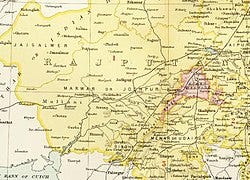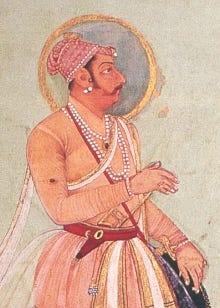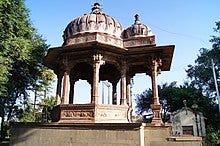Durgadas Rathore
Marwar a vast sandy expanse in the south western part of Rajasthan, lying northwest of the Aravallis, through which the Luni river runs. One of the harshest environments in India, with large parts of the Thar here, as well as shifting sand dunes, low rainfall. The region gets it’s name from Maru, the local word for desert. The region consists of Jodhpur( it’s main city), Pali, Nagaur, Barmer, Jodhpur, Pali and parts of Sikar.
The Rathores who were the main Rajput clan in Jodhpur, claimed their descent from the Rastrakutas, and after the dynasty’s fall migrated to Kannauj. After Muhammad Ghori sacked the city in 1194, and it’s capture by the Delhi Sultanate later, they fled west. It’s believed that Siyaji, grandson of Jai Chand, the last Gahadvala ruler, had come to Pali on a piligrimage to Dwaraka. He settled there to protect the local Brahmins, from the raids of bandits, and would eventually settle there. Rao Chanda, the succesor of Siyaji, would later wrest Mandore, and most of Marwar from the Sultanate with the help of the Parihar clans.
The princely state of Jodhpur was founded in 1459 by Rao Jodha, after whom it was named. While the Rathores did rule over other princely states like Bikaner, Kishangarh, Ratlam, Jhabua, it was Jodhpur that was the most prominent of all.Though he had a long rivalry with Rana Kumbha of Mewar over the murder of his father, he later settled the differences with him.
Following the death of Chandrasen Rathore in 1581, Jodhpur was annexed by the Mughals. Though Akbar restored Udai Singh to the throne in 1583, the princely state more or less remained a vassal of the Mughals. In 1638, Maharaja Jaswant Singh Rathore was coronated as the ruler. When Aurangzeb along with his brother Murad, rebelled against his father, Shahjahan, Jaswant Singh was asked to subdue the revolt bt the Emperor. However he had to suffer heavy losses, in the battle with Aurangzeb, and lost around 6000 of his men, that included the Maharaja of Ratlam, Ratan Singh Rathore.
Add to it Jaswant Singh lost his son Prithviraj Singh in 1667, who was believed to have been poisoned to death by Aurangzeb, leaving him with no male heir. And he himself passed away during a campaign at Jamrud in 1678. The stage was set for Aurangzeb’s complete take over of Marwar, which till then was autonomous, though under the Mughals. Until one man stood in the way.
Durgadas Rathore, the general of the Marwar army, whose father Askaran Rathore, was a minister in Jaswant Singh’s court.He was also distinctly related to the royal family being a descendant of Rao Ranmal.
After Jaswant Singh passed away, both of his queens gave birth to one male child each. However with one of them passing away as an infant, the other one, Ajit Singh, became the sole legitimate heir to the throne. However Aurangzeb refused to recognize Ajit Singh as the heir, imposed the jizya tax in Jodhpur state, and imposed his stooge Indra Singh as the new ruler.
When Durgadas met Aurangzeb, to plead for the recognition of Ajit Singh as the heir, he refused, but was willing to bestow a title and grant when the boy grew up. He also wanted Ajit Singh to grow up in the Mughal harem, and accept Islam, as well as sending Jaswant Singh’s queens to the harem too.
A furious Durgadas, walked out, refusing to accept the humiliating terms, and resolved to make Ajit Singh the ruler of Marwar, even if it meant having to face up to the mighty Mughal army. Taking personal responsibility for Ajit Singh and the queens, Durgadas shifted them out from Delhi in 1679. Pursued by the Mughal army, he along with his band of followers, resisted furiously, fighting many a rearguard action. The Mughal forces, had to retreat in the face of a strong counter offensive, the child Ajit Singh was taken first to Balunda, and later to Mount Abu,where he was sheltered in the safety of the Aravallis.
Aurangzeb deposed the incompetent Indra Singh, and placed Marwar directly under Mughal rule, stripping it of all it’s autonomy. It was a terrible period for Marwar, as the Mughal forces went on a rampage, destroying temples, looting the prosperous trading towns there and indulging in widespread massacres of Hindus. Aurangzeb also placed the son of a milkman on the throne, while denouncing Ajit Singh as an imposter.
It was during this dark phase of Marwar, that Durgadas waged a constant resistance to the Mughals, harassing them in a series of guerilla raids. Also with Aurangzeb attacking Mewar, the Ranas too joined hands, as two of the largest Rajput states, revolted against the Mughal Empire. In the meantime, Aurangzeb’s rather incompetent son Akbar, had revolted against his father and allied with the Rajputs. Though Durgadas assisted Akbar, the revolt failed, as he fled to the court of the Maratha ruler, Sambhaji. This forced Aurangzeb to make peace with Mewar, however Marwar would still have to face a long war.
Durgadas who was in the Deccan, returned in 1687, to join hands with Ajit Singh, who was now a grown up youth. The Rathores were now engaged in a long war, and though they changed tactics with a more open approach, they still could not, wrest back Marwar, from the Mughals. Akbar died in exile in 1704, leaving his children in custody of the Rathores. Anxious to have his grand children back, Aurangzeb negotiated with Durgadas, he however refused to restore Marwar back to the Rathores. He rather came up with a compromise, giving Ajit Singh a lesser jagir, and appointing Durgadas as the commandant in charge of Gujarat.
However Aurangzeb, still continued to view the Rathores with suspicion, and in 1702, ordered the Gujarat governor to get rid of Durgadas either by arrest or murder. Having got wind of the Emperor’s intentions, Durgadas fled to Marwar, where he once again, raised a rebel band. However with age catching up, and the rebels being poorly funded, and trained he had limited success. Add to it, Ajit Singh, had by now become jealous of Durgadas popularity and influence, and tried to under cut him.
With the passing away of Aurangzeb in 1707, Durgadas, eventually recaptured Jodhpur, throwing out the Mughals from Marwar. Ajit Singh was proclaimed as Maharaja,and he would later rebuild all the temples destroyed by the Mughals.
With Marwar now back in the control of the Rathores, Durgadas, renounced everything, and spent his last days in pilgrimage, travelling through Sadri, Udaipur, before settling down at Ujjain, where he ultimately passed away on November 22, 1718, at the age of 81 years. His canopy still exists in Chakratheertha, Ujjain, which is visited by many.
Durgadas Rathore, a true hero and warrior, who fought the Mughals for twenty five years, recaptured Marwar back and then renounced it all. A truly selfless soul, who sacrificed his all to ensure that Ajit Singh, the rightful heir, would get to rule over Marwar.








